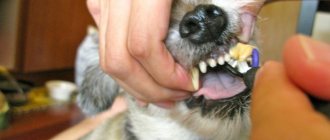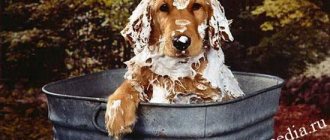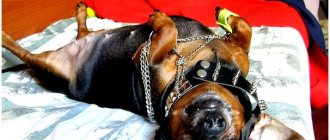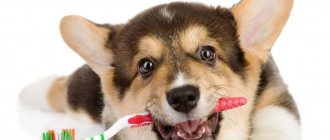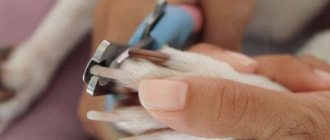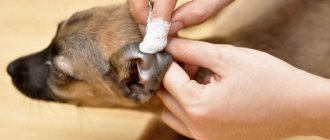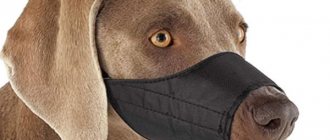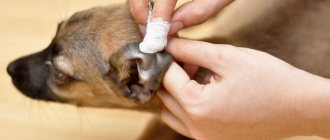Grooming your dog should not be done occasionally, but regularly. In particular, we are talking about ear care and cleaning. This procedure is not performed when the ears are dirty or there is some discharge, but regularly for hygienic purposes. Periodic examination is necessary in order to reduce the risk of possible bacterial and fungal diseases, prevent the occurrence of inflammatory processes or the appearance of ectoparasites. This seemingly simple procedure must be performed correctly; it has certain features and rules.
Symptoms of infectious diseases
An infection of the ear canal is usually accompanied by the following phenomena:
- Swelling of the skin.
- Excessive discharge.
- Unpleasant smell.
- Heat.
- Poor appetite.
- Itching and severe pain.
- Redness.
A sick dog will whine and constantly touch its ears with its paws. If these signs are present, your pet should be taken to see a veterinarian. Self-medication of the animal is not allowed. This can lead to serious complications and death of the dog.
The ears must be examined daily. You can determine the condition of the ear canal using a cotton swab dipped in warm water. If a light gray or brown coating remains on it, then cleaning is not required. If the ear canal is significantly contaminated, pieces of wax will stick to the tampon. This suggests that it is time for hygiene procedures.
Importance of the procedure
Cleaning a dog’s ear is a disease prevention and a way to promptly detect disorders that require a veterinary examination and proper treatment. The appearance of an unpleasant odor is a signal of problems. It could be a mite, yeast-like fungi, or bacteria.
Expert opinion
Anna Abramenko
An avid dog lover. Experience in veterinary medicine since 2009.
Ask a Question
Cleaning your ears on time is important. The question concerns not only the aesthetic side, but also health. When a large amount of sulfur secretions accumulates, a dog may develop otitis media. Parasites are often associated with inflammation.
When should you clean your dog's ears?
An animal should not clean its ears every day. This is especially true for breeds that have short ears and not very long hair. A small amount of sulfur in the ear canal protects the ears from exposure to adverse external factors (dust, microorganisms, particulate matter). A healthy ear canal is usually pale pink in color.
The dog's ear has a unique ability to clean itself. It occurs due to the migration of epithelial cells that line the ear canal. Ear problems arise due to injuries, illnesses, unfavorable ecology and heavy dust in the premises in which the animal is located.
If your dog has floppy ears and long hair, then ear cleaning should be done every 3-4 days. The same goes for older animals and dogs that spend a lot of time outside. Small “lap” dogs do not require frequent hygiene procedures.
The dog's ears must be wiped after water procedures. This recommendation is especially true for Labradors who love to swim. Dirty water entering the inner ear can cause infectious diseases. The cause of contamination can also be particles of earth that get into the ear during active “excavations” carried out by the dog.
How to clean your ears
To clean the ear canal you can use:
- Cotton pads. These products are made from natural materials that do not cause allergies. Hygiene items have a textured surface and absorb moisture well. Using discs, you can easily remove dirt from your animal’s ears without the risk of damaging the skin.
- Special wipes for dogs are sold in all veterinary pharmacies. They are impregnated with a hypoallergenic composition that effectively dissolves dried dirt and cleanses the animal's ears.
- Hygienic lotions. These drugs are instilled into the animal's ear canal. When the lotion fills the ear canal, the base of the ear should be lightly massaged. After this, the dog will begin to shake its head, and the product will come out naturally. Wet ears should be wiped with a clean cloth.
- Instead of lotions, you can use various oils that are sold at a veterinary pharmacy.
- Warmed saline solution can also be used to clean the ears.
- If your pet has long ears, you can clean them with a special powder. This product slightly dries the skin and prevents the accumulation of wet dirt in the ear canal.
When carrying out hygiene procedures, do not use medications or aggressive chemical liquids. Soap, hydrogen peroxide and baby lotions can cause severe burns, swelling and allergic reactions in your pet.
It is also not recommended to use various tinctures, decoctions and other traditional medicine when cleaning the ears. You should carefully study the composition of the medicines you buy at the pharmacy. Consider side effects and contraindications to the use of certain medications.
Use a separate tissue or swab to clean each ear. All medications that are poured into the ear must be pre-warmed to room temperature. Cold liquid will cause discomfort. The dog will begin to be afraid of washing and will avoid this procedure in every possible way.
Eczema and injuries
Black plaque in a dog's ears may indicate injury to the external auditory canal. In this case, the dark color of the exudate is due to inclusions of blood. To diagnose an injury, you need to carefully examine your pet's ears. Damage may be caused by foreign objects.
Allergic eczema is a severe form of an allergic reaction that occurs in response to medications, household chemicals and hygiene products for cleaning the ears. Characteristic symptoms:
- Dark, almost black coating.
- Severe peeling.
- Formation of cracks and erosions.
- Sores around the ear.
Antihistamines and anti-inflammatory ointments are used to treat eczema. The treatment regimen is selected by the veterinarian individually for each animal, depending on the severity of symptoms and general health.
How to clean a dog's ears at home
Care must be taken during hygiene procedures. Your actions should not cause the dog pain or severe discomfort. Cleaning the ears at home is carried out according to the following algorithm:
- Wash your hands and remove all necessary tools.
- Secure the animal. You should not catch the dog throughout the apartment when he is in an excited state. You will have to hold the caught animal tightly, giving it a lot of unpleasant sensations. The dog feels calmest after water procedures. Pet the dog and lay it on its side. Lift your ear and begin the cleaning procedure. While washing, you can talk to your pet in a quiet and calm voice.
- Clean your ear. Examine your ear carefully. If you see dried dirt, you need to use almond or olive oil to dissolve it. The sulfur should be softened with lotion. The outer part of the ear is treated with cotton pads. Before introducing the lotion, the ear must be slightly pulled back.
- Gently knead the dog's ear. These actions will speed up the dissolution of sebum and wax. The massage will relax the animal and it will calm down.
- Remove dust and wax from the ear canal. After completing the procedures, all products will come out of the animal’s ear canal naturally. The ears should be wiped dry with a clean cloth. If you are the owner of a large dog, then its ears should be cleaned with a finger wrapped in a clean cloth.
Removing hair from a dog's ears
Some dog breeds, such as poodles and schnauzers, may have hair accumulated in their ears. It quickly becomes saturated with sulfur and clogs the ear canal. This leads to hearing loss, tissue inflammation and problems with the vestibular system.
The dog will begin to scratch its ears and rub against the corners of the furniture. The animal will constantly injure the ear. The coat should be trimmed regularly with blunt scissors. You can entrust this procedure to a doctor or do everything yourself.
If the process of plucking hair causes severe discomfort and inflammation of the skin, then you can use special depilatory creams. First, a tampon soaked in Vaseline is placed in the ear canal.
After this, the cream is applied to the areas intended for depilation. Hair is removed using special rounded tweezers; synthomycin ointment is applied to areas cleared of hair (before using medications, you should consult a veterinarian).
After completing all manipulations, wipe the auricle with a damp cloth and remove the tampon with Vaseline. Some dog owners are afraid to carry out hygiene procedures on their own. These fears are completely unfounded.
The auditory canal in dogs is curved, so it is quite difficult to damage the eardrum. This requires significant physical effort. If you doubt your abilities, you can seek advice from a veterinarian. He will show you how to properly clean your pet's ears.
Bad odor from the ears may indicate a bacterial infection. In this case, it is necessary to use a chlorhexidine solution (according to a doctor's prescription). You should not use alcohol solutions to treat the disease, which can damage the sensitive skin of the ear canal.
You should also not use pencils, pens, paper clips, needles or other foreign objects when cleaning your ear. It is not recommended to clean the ear canal with cotton swabs (they can compact the wax plug).
Otomycosis
White plaque in a dog’s ears, represented by dense crusts and flaking, is a consequence of a fungal infection. The disease is usually caused by the opportunistic yeast fungus Malassezia. It is always present in the body, but its amount increases under the influence of various factors, which leads to the development of otomycosis.
Causes of fungal infection of the external auditory canal:
- endocrine disorders;
- metabolic disease;
- weakened immunity;
- allergic reactions;
- ear injuries.
All these factors lead to excessive growth of the fungal colony, which causes inflammation. When examining the ear, you may notice small cracks and flaky areas. Dense crusts are easily removed, revealing red, inflamed epidermis underneath. With otomycosis, severe itching is observed, so the dog constantly twitches its ears, itches, and shakes its head.
To make a diagnosis, it is necessary to analyze a scraping of the white discharge. In therapy, antiseptic agents, antibacterial drops are used if there is a risk of secondary infection, and local antifungal agents are used to eliminate pathogenic microflora.
Sometimes insects crawl into your dog's ears.
This happens especially often in the summer months. The greatest danger to the animal are ticks, which are carriers of dangerous infections. If you notice a tick attached to the ear, you should take your dog to the doctor.
Do not attempt to remove the insect yourself! Improper removal of the tick will result in the insect's proboscis remaining in the dog's skin, which will cause inflammation. If a foreign body (straws, blades of grass, seeds, etc.) is stuck in the animal’s ear canal, then you need to take the animal to a veterinary clinic.
How to get your dog used to ear cleaning
Some animals actively resist attempts to carry out hygiene procedures. This usually happens because the owner doesn’t clean the ears properly or doesn’t pay enough attention to raising the dog. You need to teach your dog to clean his ears from an early age.
The pet must get used to the fact that the owner carries out various manipulations with its limbs, teeth and ears. At the initial stage of training, you can simply touch the animal’s ears and massage them. It is extremely important to maintain the dog's trust and not cause him any discomfort. When the animal gets used to you, you can carefully begin the procedure of cleaning the ear canal.
Representatives of some breeds (for example, terriers) are extremely stubborn and do not allow their ears to be cleaned. The owner must show persistence and patience. He must, with the help of affection and food reinforcement, convince the animal of the need for hygiene procedures. Screaming and violent actions when communicating with an animal are not allowed.
You can also read our article: “How to wash a dog’s eyes at home”, how to properly care for your pet’s eyes, rinsing and hygiene products.
What can a veterinarian do?
The veterinarian will examine the patient, carry out initial cleaning of the ears, make the correct diagnosis, instill medicine, carry out treatment, and lubricate the ear. In addition, a competent specialist will give valuable recommendations on what medications the dog should be treated with, how to treat the ear canal, select individual ear hygiene products and tell you how to carry out the procedure without putting much pressure on the animal’s psyche.
Veterinarians not only treat our little brothers, but are also partly zoopsychologists and know many methods to facilitate communication between animals and humans. You must carefully monitor the doctor’s actions and repeat them exactly at home. All the veterinarian’s instructions must be followed unquestioningly: an overdose of a medicine or cleanser can lead to serious damage to the skin, and a deficiency can lead to the habituation of pathogenic microbes and fungi, their adaptation to the active substances.
If you suspect a fungus, you should definitely contact your veterinarian.
The veterinarian will probably make several appointments on certain days, during which he will note the improvement or deterioration of the patient’s condition, adjust the treatment in case of failure, and prescribe preventive measures and recommendations in case of success.
